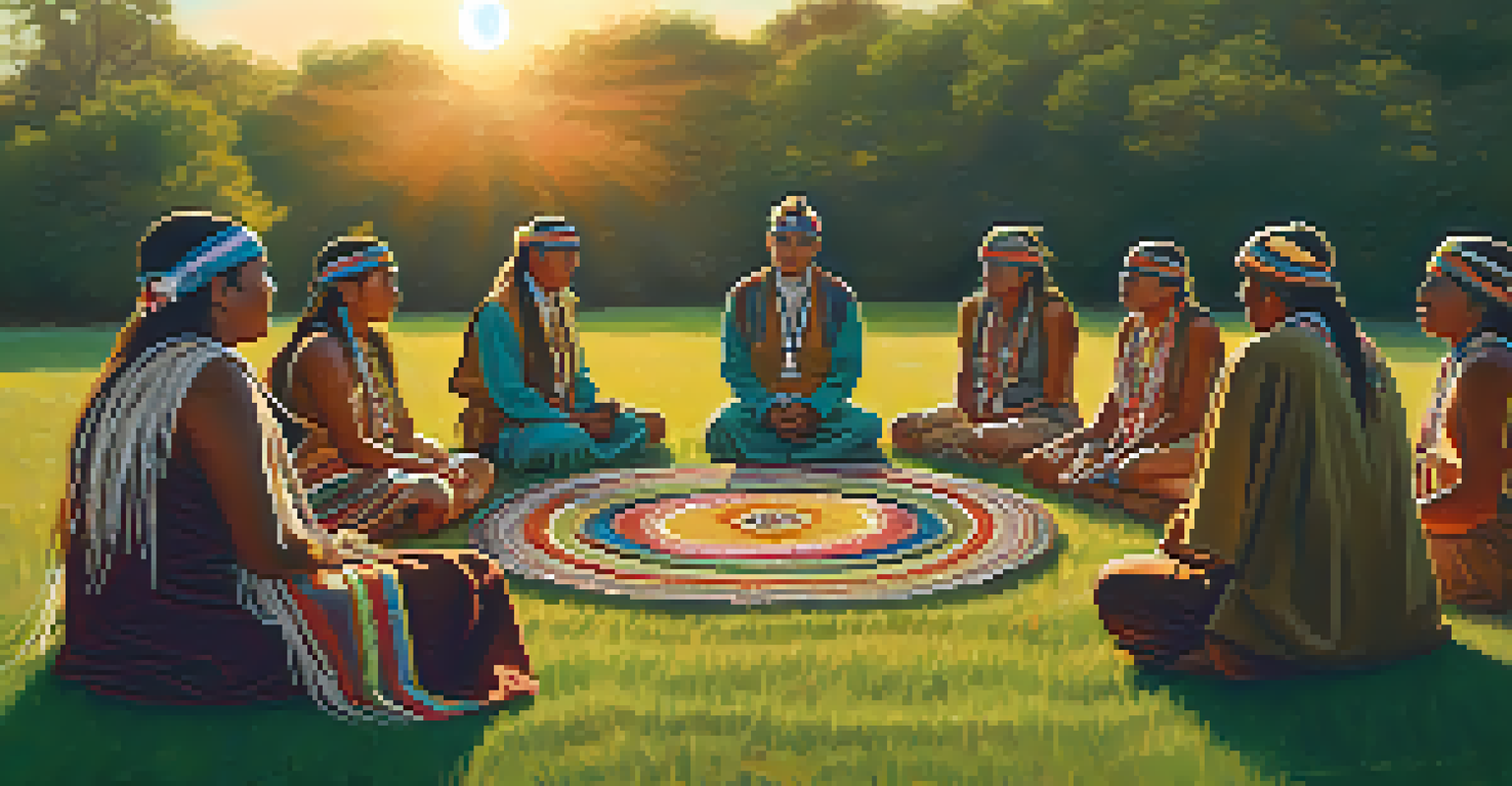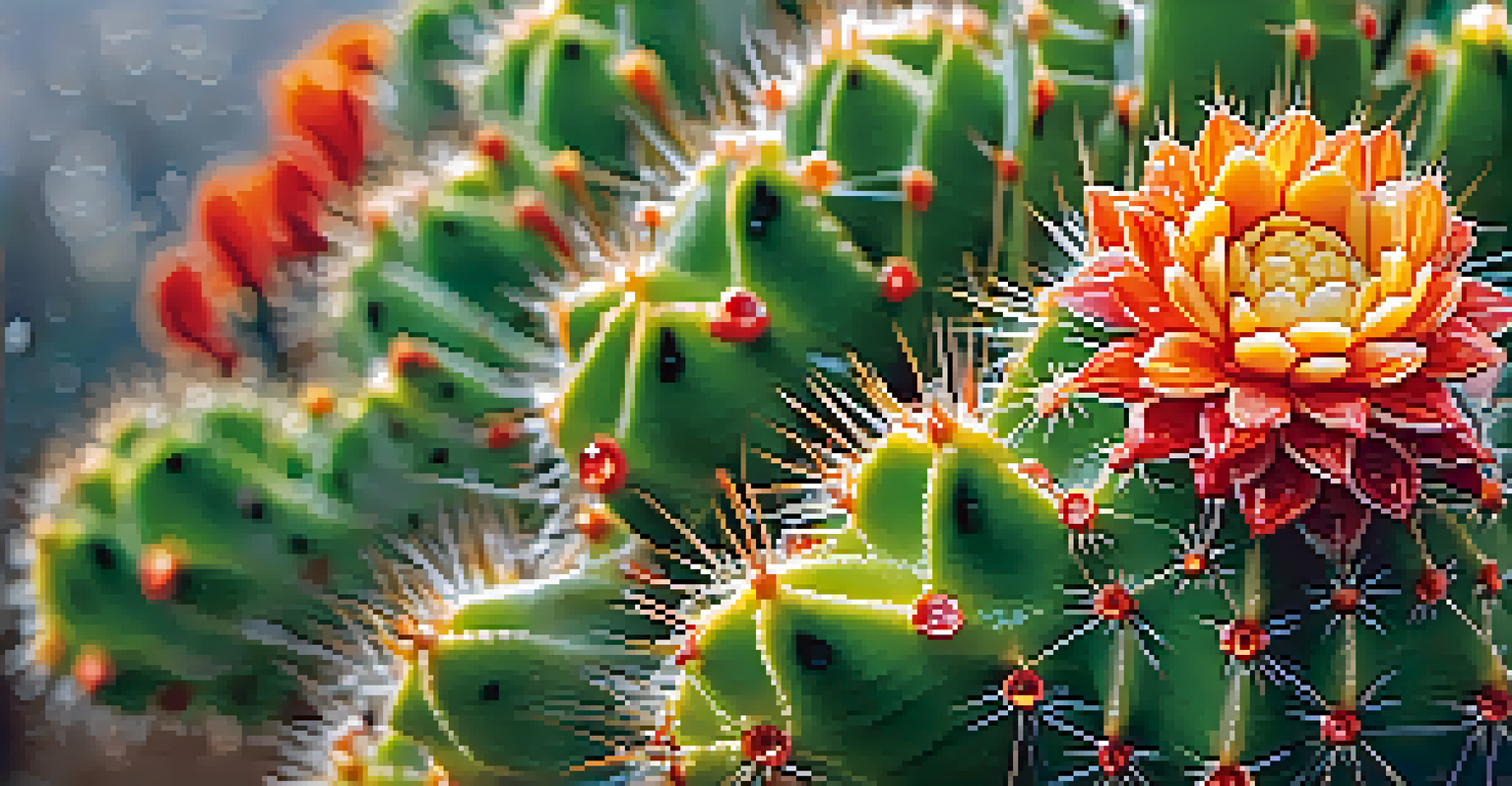The Role of Peyote in Indigenous Social Justice Movements

The Significance of Peyote in Indigenous Cultures
Peyote, a small cactus native to North America, has deep cultural significance for many Indigenous peoples. It has been used for centuries not just as a sacrament in spiritual ceremonies but also as a means of connecting with their heritage. For many tribes, such as the Huichol and the Lakota, peyote serves as a bridge between the physical and spiritual worlds, reinforcing their community bonds.
The plant is not just a tool for healing but a symbol of resistance and cultural pride within Indigenous movements.
The cactus is more than just a plant; it symbolizes resilience and identity. As Indigenous communities face ongoing challenges related to colonization and cultural erasure, peyote plays a crucial role in preserving their traditions and languages. Through ceremonies, they pass down stories and teachings that have been preserved for generations.
Using peyote in their rituals helps Indigenous people reclaim their narratives and assert their rights. This aspect of cultural pride is essential, especially in the context of social justice movements that seek to address the historical injustices faced by these communities.
Peyote and Spiritual Practices in Indigenous Movements
Spirituality and social justice are intertwined in many Indigenous movements, with peyote serving as a central element. During ceremonies, participants often seek guidance and healing, using peyote as a tool for introspection and connection with their ancestors. These spiritual practices foster a sense of unity and purpose, empowering individuals to advocate for their rights.

The spiritual experiences facilitated by peyote can lead to profound realizations about social justice issues. Participants often emerge from ceremonies with renewed vigor to fight against oppression, advocating for policy changes that impact their communities. This blend of spirituality and activism is a powerful driver for social change.
Peyote's Role in Indigenous Identity
Peyote serves as a vital symbol of resilience and cultural identity for Indigenous peoples, connecting them to their heritage and traditions.
Moreover, these ceremonies promote cultural understanding and solidarity among Indigenous peoples. By coming together to share their experiences and beliefs, they strengthen their movements and build a network of support that transcends tribal boundaries.
Legal Challenges Surrounding Peyote Use
Despite its cultural significance, the use of peyote faces numerous legal challenges. In the United States, for example, the American Indian Religious Freedom Act allows for the use of peyote in religious ceremonies, but this protection often doesn't extend to other aspects of Indigenous rights. This legal ambiguity can create hurdles for those seeking to freely practice their traditions.
Indigenous peoples are not just fighting for their rights; they are fighting for their identity and their very existence.
Additionally, the increasing popularity of peyote among non-Indigenous users raises concerns about the sustainability of the cactus. Overharvesting can threaten its availability for Indigenous communities who rely on it for spiritual practices. This situation illustrates the complex dynamics of cultural appropriation and the need for respectful dialogue about Indigenous rights.
Legal battles surrounding peyote also highlight broader issues of sovereignty. Indigenous groups are often forced to navigate a legal system that does not fully recognize their rights or the importance of their traditions, which can be frustrating and disheartening.
The Intersection of Peyote and Mental Health
Recent studies have highlighted the potential therapeutic benefits of peyote, particularly in the context of mental health. Indigenous peoples often grapple with the psychological impacts of colonization, including trauma and loss of identity. Peyote ceremonies provide a safe space for individuals to confront these issues, promoting healing and resilience.
In many communities, mental health is viewed holistically, intertwining spiritual and emotional well-being. Peyote can facilitate this healing process by helping participants navigate their feelings and experiences, fostering a sense of belonging and understanding. This aspect of peyote usage is increasingly recognized in discussions about mental health care.
Legal Challenges of Peyote Use
Despite its cultural significance, peyote use faces legal hurdles that complicate the rights of Indigenous communities to practice their traditions freely.
As mental health awareness grows, the role of traditional practices like peyote ceremonies is gaining traction. Indigenous leaders advocate for the integration of these practices into broader health care systems, emphasizing the importance of culturally appropriate resources for healing.
Global Perspectives on Peyote and Indigenous Rights
The significance of peyote extends beyond North America; it resonates with Indigenous peoples worldwide who fight for their rights. Global movements for Indigenous sovereignty often draw parallels with the struggles faced by Native American communities, creating a shared sense of purpose. This interconnectedness underscores the necessity of supporting Indigenous rights on a global scale.
Peyote serves as a symbol of resistance and cultural pride within these movements. As communities unite to advocate for their rights, they highlight the importance of protecting sacred plants and traditional practices. This solidarity can amplify their voices and foster understanding among diverse groups.
International forums and collaborations allow Indigenous leaders to share their experiences and strategies. By learning from one another, they can strengthen their movements and raise awareness about the importance of preserving their cultural heritage.
Youth Engagement and the Future of Peyote Practices
As Indigenous youth become more involved in social justice movements, peyote plays a crucial role in their cultural revitalization efforts. Many young people are rediscovering their heritage and finding strength in traditional practices, including peyote ceremonies. This rekindling of interest is vital for the continuity of their cultures.
Youth engagement in peyote practices also fosters leadership skills, empowering the next generation to advocate for their rights. By participating in ceremonies and learning about their cultural significance, young people develop a deeper understanding of their identity and the importance of social justice. This connection can inspire them to take action in their communities.
Peyote and Mental Health Healing
Peyote ceremonies provide a holistic approach to mental health, offering Indigenous individuals a space to confront trauma and promote healing.
Moreover, as they navigate contemporary challenges, Indigenous youth are finding innovative ways to blend traditional practices with modern activism. This dynamic approach not only honors their heritage but also ensures that peyote and its teachings remain relevant in today's world.
Conclusion: The Ongoing Journey for Justice and Recognition
The role of peyote in Indigenous social justice movements is multifaceted, intertwining spirituality, culture, and activism. As Indigenous communities continue to fight for their rights, peyote remains a powerful symbol of resilience and identity. This journey is not just about preserving traditions; it's also about advocating for a future where Indigenous voices are heard and respected.
Recognizing the significance of peyote is essential for understanding the broader context of Indigenous struggles. Supporting these movements means acknowledging their cultural heritage and the challenges they face. It's a call to action for all of us to stand in solidarity with Indigenous peoples.

Ultimately, the ongoing fight for justice and recognition is a collective responsibility. As we learn about and appreciate the role of peyote, we can contribute to a more equitable future for Indigenous communities, ensuring that their rights and traditions are honored for generations to come.